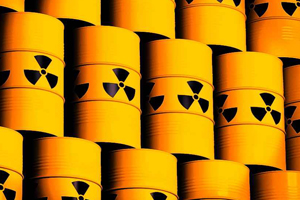Ru
|
Eng
Belarusian technologies for more effective nuclear waste utilization
28.05.2015

Research products developed by the United Energy and Nuclear Research Institute Sosny of the National Academy of Sciences of Belarus (NASB) will help improve the effectiveness of mobilization and utilization of radioactive waste produced by nuclear power plants, BelTA learned from Vladimir Nemtsev, Doctor of Science (Engineering), a laboratory head at the Institute, during the international symposium on promising materials and technologies in Vitebsk on 28 May.
At present storing radioactive waste in an isolated and safe environment for as long as at least ten half-life periods of the controlled isotope is believed to be the most acceptable way of handling radioactive waste. Steel barrels and reinforced concrete containers are often used to store radioactive waste. Vladimir Nemtsev remarked that the choice of the material to make the packaging is very important. The United Energy and Nuclear Research Institute Sosny has researched and proved the viability of using composite thermoplastic materials to make radioactive waste containers. The technology to make the materials is well-studied and practiced in Belarus.
Composite thermoplastic materials consist of plastic binder and mineral filler. Secondary polymers such as polyethylene film waste and things like that can be the binder. Common sand, crushed glass, sawdust, solid industrial waste can be the filler. Composite thermoplastic materials boast unique physical and chemical qualities, including high mechanical strength, resistance to chemical and radioactive impact. They are also cheap to make using simple technologies. Research into the radiation stability of the composite thermoplastic material made of sand and polyethylene film waste indicates that containers made of the material will be usable for at least 1,000 years. In other words, the material can be used for storage and disposal of radioactive waste, stressed Vladimir Nemtsev. All the countries that develop nuclear power industries need such containers, this is why containers made of composite thermoplastic materials have a considerable export potential.
The international symposium on promising materials and technologies gathered over 130 scientists from ten countries. Participants of the event are expected to discuss the latest results of scientific research in the area of synthesis and creation of new materials, promising advances in ultrasound applications. Achievements in creating alloys with plastic recovery effects, surface machining, synthesis of polymeric materials and crystal structures, methods to control the structure and friction qualities of materials will be presented. The forum’s agenda also includes discussions about prospects of development and priority avenues of materials science.
The symposium has been organized by the National Academy of Sciences of Belarus, the interstate coordinating council for physics of strength and plasticity of materials, the Belarusian Education Ministry, the Vitebsk Oblast administration, the Vitebsk State Technical University, the Acoustic Engineering Institute of the National Academy of Sciences of Belarus.
At present storing radioactive waste in an isolated and safe environment for as long as at least ten half-life periods of the controlled isotope is believed to be the most acceptable way of handling radioactive waste. Steel barrels and reinforced concrete containers are often used to store radioactive waste. Vladimir Nemtsev remarked that the choice of the material to make the packaging is very important. The United Energy and Nuclear Research Institute Sosny has researched and proved the viability of using composite thermoplastic materials to make radioactive waste containers. The technology to make the materials is well-studied and practiced in Belarus.
Composite thermoplastic materials consist of plastic binder and mineral filler. Secondary polymers such as polyethylene film waste and things like that can be the binder. Common sand, crushed glass, sawdust, solid industrial waste can be the filler. Composite thermoplastic materials boast unique physical and chemical qualities, including high mechanical strength, resistance to chemical and radioactive impact. They are also cheap to make using simple technologies. Research into the radiation stability of the composite thermoplastic material made of sand and polyethylene film waste indicates that containers made of the material will be usable for at least 1,000 years. In other words, the material can be used for storage and disposal of radioactive waste, stressed Vladimir Nemtsev. All the countries that develop nuclear power industries need such containers, this is why containers made of composite thermoplastic materials have a considerable export potential.
The international symposium on promising materials and technologies gathered over 130 scientists from ten countries. Participants of the event are expected to discuss the latest results of scientific research in the area of synthesis and creation of new materials, promising advances in ultrasound applications. Achievements in creating alloys with plastic recovery effects, surface machining, synthesis of polymeric materials and crystal structures, methods to control the structure and friction qualities of materials will be presented. The forum’s agenda also includes discussions about prospects of development and priority avenues of materials science.
The symposium has been organized by the National Academy of Sciences of Belarus, the interstate coordinating council for physics of strength and plasticity of materials, the Belarusian Education Ministry, the Vitebsk Oblast administration, the Vitebsk State Technical University, the Acoustic Engineering Institute of the National Academy of Sciences of Belarus.
NEWSWIRE
17.07.2024
02.07.2024
27.06.2024
21.06.2024
19.06.2024
06.06.2024
06.06.2024
06.06.2024
06.06.2024
06.06.2024













